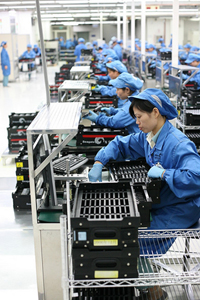 On 11 December 2011 the People’s Republic of China (PRC) marked the 10th anniversary of its entry into the World Trade Organization.
On 11 December 2011 the People’s Republic of China (PRC) marked the 10th anniversary of its entry into the World Trade Organization.
The PRC’s trade statistics over the past decade have been impressive: despite the fragile global recovery, its exports surged 31% to reach $1.6 trillion in 2010, more than six times the value in 2000. For the first time, the PRC overtook Germany to become the world’s largest exporter.
The PRC’s high-tech exports were valued at $490 billion and accounted for 31% of its total exports in 2010. A report from European Commission in 2009 concluded that the PRC had surpassed the United States, Japan and the 27 states of the European Union to emerge as the world’s largest high-tech exporter.1
According to statistics from the US Department of Commerce, in 2010 the PRC even ran a $94 billion surplus in advanced technology products to the US, an undisputed world leader in technology innovation.
Is the PRC really the world’s No.1 high-tech exporter?
The answer is definitely no. The trade statistics cited above are misleading, and too crude to give a true picture of modern international trade, which has been shaped by sophisticated global supply chains beyond our imagination.
More than half of the PRC’s exports are “processing exports”—products made of imported parts and components. Most of these products are sold not under Chinese but under foreign brands—a critical factor if made-in-the PRC products are ever to dominate the world market.
Moreover, 82% of “high-tech” exports are assembled with imported parts and components. Little of the intellectual property that underpins them is generated in the PRC. It is misleading to classify these assembled products as high-tech exports, as Chinese workers contributed only low-skilled labor to their production. Such exports should be classified as “assembled high-tech” and put into the same category as traditional labor-intensive products, such as T-shirts, shoes and toys.
The iPhone is a typical example. All iPhones are assembled in the PRC. Whenever an iPhone is shipped abroad, $178.96 is credited to the PRC’s high-tech exports, although Chinese workers simply screwed imported parts together and added merely $6.50 to the value of each iPhone. 2
Laptops represent the single largest item in the PRC’s high-tech exports: $53 billion in 2009. About 99% of the laptops made in the world are assembled in the PRC. However, US companies own the intellectual property for both their central operating systems (CPUs) and their operating systems.
After more than three decades of rapid economic growth, Chinese industries still remain at the bottom of the smile curve. No Chinese brand has entered the top 100 global brands.
Numerous factors obstruct firms from the PRC from climbing global supply chains, but the first thing that needs to be changed is the mindset and business philosophy of Chinese entrepreneurs.
Firms from the PRC have been very successful in copying and imitating foreign products and designs. Thanks to a huge supply of low-cost labor, Chinese companies can make cheaper products, but unfortunately not better products, than their competitors in developed countries. That is why tourists coming from the PRC to Japan always look for electronic products that are made there.
Switching from a “me too and cheaper” to a “me too and better” strategy is essential if Chinese firms are to escape being locked at the bottom of the smile curve.
However, for this to happen the PRC will need to nurture craftsmanship and professionalism among Chinese workers.
Martin Luther King gave the best definition of craftsmanship and professionalism: “If a man is called to be a street sweeper, he should sweep streets even as Michelangelo painted or Beethoven composed music or Shakespeare wrote poetry.” I see Japanese floor sweepers every day in my office building. Their dedication to their work provides a vivid footnote to the high quality of Japanese products.
Everyone agrees that technology innovations, newly designed products and globally recognized brands would bring Chinese firms one rung higher on the global supply chains. However, to achieve any of these will require a long-term business philosophy.
Focusing only on short-term profitability and being too impatient to wait for long-term success stops companies from creating new products. If Chinese firms are serious about inventing new technology, being unique, and producing the best goods in the world, they need to keep their eyes on the long-term horizon. Three decades ago Chinese entrepreneurs did not have the luxury of being able to take risks in the hope of gains in a distant future. However, given the accumulation of wealth and experience in the PRC, it is time for Chinese entrepreneurs to behave like real entrepreneurs: taking risks in the name of new ideas, spending time as well as capital on uncertain ventures.
Such a new business philosophy would allow Chinese industries to climb the ladder of global supply chains and make government subsidies for technology innovations more effective. Only if corporate R&D investment matches the PRC’s status as the world’s second largest economy will “assembled in the PRC” be transformed into “made and designed by the PRC”.
_____
1 T, Meri. 2009. China passes the EU in High-tech exports. Eurostat. 25/9.
2 Y. Xing and N. Detert. How the iPhone Widens the United States Trade Deficit with the People’s Republic of China. ADBI Working Paper No. 257. Tokyo: ADBI.
This article was originally published on December 9, 2011 in China Daily. Yuqing Xing explores these ideas further in his ADBI working paper with Neal Detert How the iPhone Widens the United States Trade Deficit with the People’s Republic of China.







Where is China’s Steve Jobs? There must be someone in China that has the talent and vision to invent new technologies products that people will want to buy.